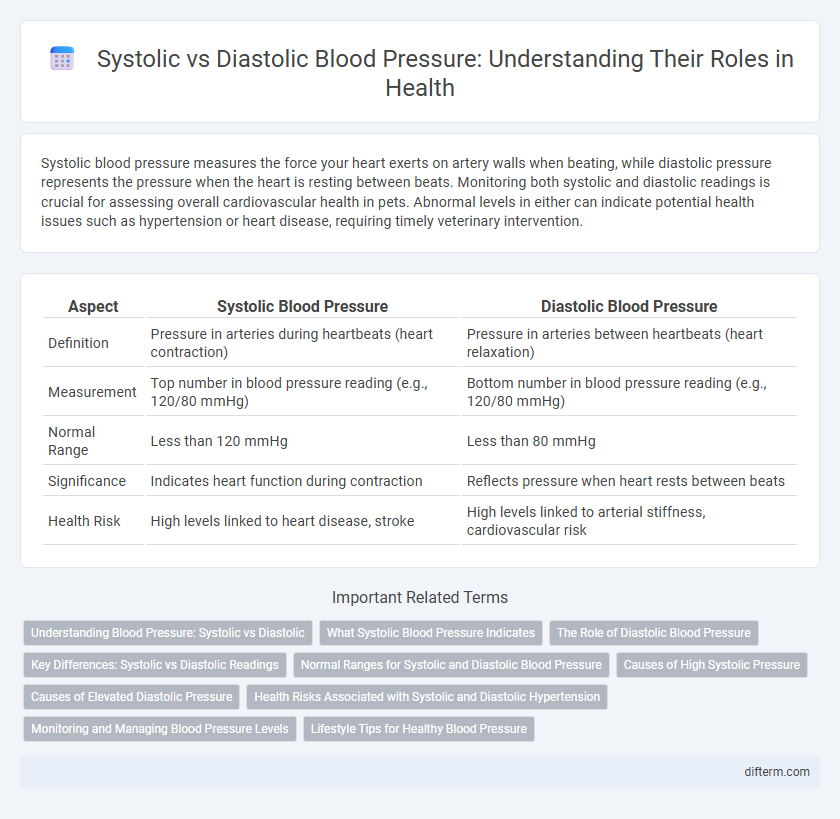Systolic blood pressure measures the force your heart exerts on artery walls when beating, while diastolic pressure represents the pressure when the heart is resting between beats. Monitoring both systolic and diastolic readings is crucial for assessing overall cardiovascular health in pets. Abnormal levels in either can indicate potential health issues such as hypertension or heart disease, requiring timely veterinary intervention.
Table of Comparison
| Aspect | Systolic Blood Pressure | Diastolic Blood Pressure |
|---|---|---|
| Definition | Pressure in arteries during heartbeats (heart contraction) | Pressure in arteries between heartbeats (heart relaxation) |
| Measurement | Top number in blood pressure reading (e.g., 120/80 mmHg) | Bottom number in blood pressure reading (e.g., 120/80 mmHg) |
| Normal Range | Less than 120 mmHg | Less than 80 mmHg |
| Significance | Indicates heart function during contraction | Reflects pressure when heart rests between beats |
| Health Risk | High levels linked to heart disease, stroke | High levels linked to arterial stiffness, cardiovascular risk |
Understanding Blood Pressure: Systolic vs Diastolic
Systolic blood pressure measures the force exerted on artery walls when the heart contracts, indicating the peak pressure during a heartbeat. Diastolic blood pressure represents the pressure in the arteries when the heart rests between beats, reflecting the baseline arterial tension. Accurate understanding of both systolic and diastolic values is crucial for diagnosing hypertension and managing cardiovascular health effectively.
What Systolic Blood Pressure Indicates
Systolic blood pressure measures the force exerted on artery walls when the heart contracts to pump blood, reflecting cardiovascular health and heart function. Elevated systolic readings can indicate increased risk for hypertension, heart disease, and stroke, making it a critical metric in medical assessments. Monitoring systolic pressure helps detect arterial stiffness and potential damage, guiding treatment and lifestyle interventions.
The Role of Diastolic Blood Pressure
Diastolic blood pressure measures the force exerted on artery walls when the heart rests between beats, playing a crucial role in maintaining adequate tissue perfusion and organ function. Elevated diastolic pressure can indicate increased vascular resistance and is a key factor in diagnosing hypertension and assessing cardiovascular risk. Monitoring diastolic values alongside systolic pressure provides a comprehensive understanding of overall cardiovascular health and guides effective treatment strategies.
Key Differences: Systolic vs Diastolic Readings
Systolic blood pressure measures the force exerted on artery walls when the heart contracts, representing the higher number in a reading, while diastolic pressure measures the force when the heart is at rest between beats, denoted as the lower number. Key differences include that elevated systolic readings often indicate potential heart disease risk and arterial stiffness, whereas high diastolic pressure may signal increased resistance in blood vessels. Accurate interpretation of both systolic and diastolic readings is critical for diagnosing hypertension and tailoring effective cardiovascular treatment plans.
Normal Ranges for Systolic and Diastolic Blood Pressure
Normal systolic blood pressure ranges from 90 to 120 mm Hg, while diastolic pressure typically falls between 60 and 80 mm Hg. Maintaining systolic and diastolic values within these ranges helps reduce the risk of cardiovascular diseases and stroke. Blood pressure readings consistently outside these limits may indicate hypertension or hypotension, necessitating medical evaluation.
Causes of High Systolic Pressure
High systolic blood pressure, often driven by arterial stiffness, increases with age due to reduced elasticity in large arteries. Factors such as obesity, excessive salt intake, chronic stress, and underlying conditions like hyperthyroidism or kidney disease also contribute to elevated systolic readings. Lifestyle choices and genetic predispositions further exacerbate the risk of sustained high systolic pressure, heightening the chance of cardiovascular complications.
Causes of Elevated Diastolic Pressure
Elevated diastolic blood pressure often results from increased resistance in the small arteries and arterioles due to factors such as chronic stress, obesity, and excessive sodium intake. Conditions like sleep apnea, kidney disease, and hormonal imbalances, including hyperthyroidism and adrenal gland disorders, also contribute to diastolic hypertension. Identifying and managing these underlying causes is crucial for reducing the risk of cardiovascular complications.
Health Risks Associated with Systolic and Diastolic Hypertension
Systolic hypertension increases the risk of cardiovascular events such as heart attacks and strokes due to elevated pressure exerted during heartbeats, while diastolic hypertension is linked to damage in the arteries and potential kidney dysfunction from sustained high pressure between beats. Both conditions contribute to the development of left ventricular hypertrophy and heart failure if left untreated. Effective management of systolic and diastolic blood pressure is critical to reducing the incidence of these severe health complications.
Monitoring and Managing Blood Pressure Levels
Monitoring systolic and diastolic blood pressure is crucial for accurately assessing cardiovascular health and preventing hypertension-related complications. Regular tracking using validated devices helps detect abnormal readings early, enabling timely lifestyle modifications and medication adjustments. Effective management relies on understanding the distinct roles of systolic pressure, indicating arterial force during heartbeats, and diastolic pressure, reflecting pressure between beats, to tailor personalized treatment plans.
Lifestyle Tips for Healthy Blood Pressure
Maintaining a balanced diet rich in fruits, vegetables, and low-fat dairy products can help control systolic and diastolic blood pressure levels effectively. Regular physical activity, such as brisk walking for at least 30 minutes most days, supports healthy artery function and reduces hypertension risk. Limiting sodium intake to under 2,300 mg daily, managing stress through mindfulness or yoga, and avoiding tobacco use are essential lifestyle habits for optimal blood pressure.
Systolic vs Diastolic blood pressure Infographic

 difterm.com
difterm.com